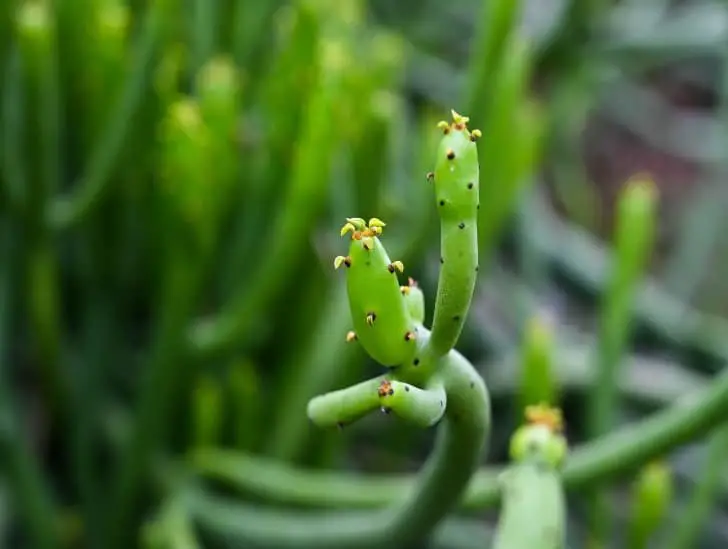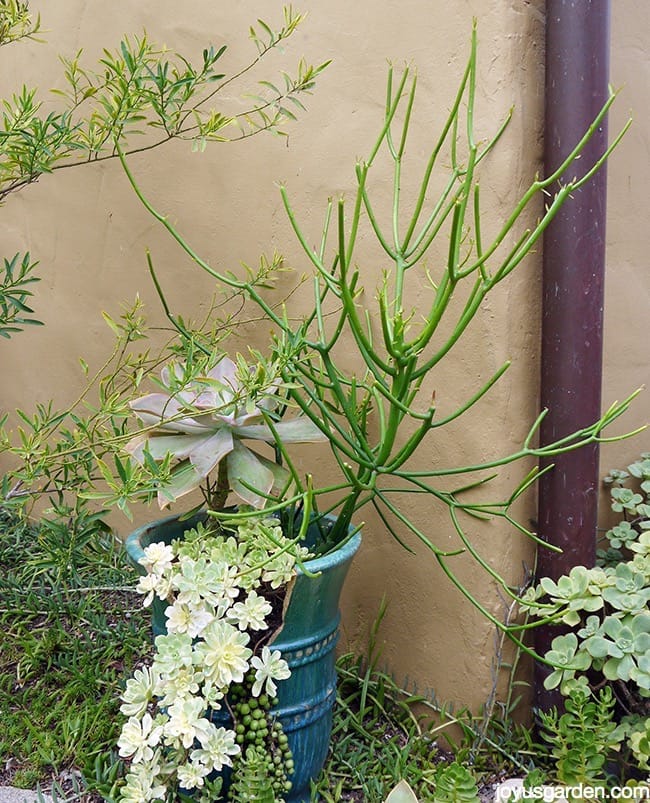The Pencil Cactus: Does It Bloom Or Not

The pencil cactus (Euphorbia tirucalli) is a succulent plant that originates from Africa. It gets its name from its long, thin, cylindrical branches that resemble pencils. The pencil cactus can grow up to 20 feet tall and 6 inches in diameter.
It’s a fast-growing plant that is often used as an ornamental houseplant or in landscaping design. Despite its popularity, there is some confusion about whether or not the pencil cactus blooms.
GROWING PENCIL CACTUS: Dos & Donts – Care Tips and Propagation of Milkbush
The pencil cactus (Euphorbia tirucalli) is a succulent plant that is native to Africa and Asia. It gets its name from its long, thin, cylindrical leaves that resemble pencils. The pencil cactus is a drought-tolerant plant that can grow up to 20 feet tall.
It is often used as an ornamental plant in gardens and landscaping.
The pencil cactus does bloom, but the flowers are small and not very showy. They are typically white or greenish-yellow in color and grow in clusters at the tips of the stems.
The blooming period for the pencil cactus is usually from late spring to early summer.
Pencil Cactus Vs Fire Stick
The Pencil Cactus and the Fire Stick are two of the most popular succulents on the market. They are both beautiful plants that can add a touch of elegance to any home or office. But which one is right for you?
Here’s a comparison of the two plants to help you decide.
Size: The Pencil Cactus is a bit taller than the Fire Stick, reaching up to 2 feet in height. The Fire Stick, on the other hand, stays shorter, only growing to about 1 foot in height.
Water needs: Both plants are drought tolerant and don’t need much water to survive. However, the Pencil Cactus is more tolerant of dry conditions than the Fire Stick. So if you’re looking for a plant that can withstand being neglected for a while, then the Pencil Cactus is your best bet.
Light needs: The Pencil Cactus prefers bright light but can also tolerate some shade. The Fire Stick also prefers bright light but will scorch if it gets too much sun. So if you’re looking for a plant that can tolerate both full sun and partial shade, then the Fire Stick is your best bet.
So there you have it! A comparison of thePencil Cactus and theFire Stick. Both are beautiful plants that make great additions to any home or office, but each has its own unique quirks that may make one better suited for your needs than the other.
Can You Grow Pencil Cactus Indoors
If you’re looking for a low-maintenance, drought-tolerant plant to add to your indoor landscape, consider the pencil cactus (Euphorbia tirucalli). Also called milk bush or Indian tree spurge, this succulent is native to Africa and Asia and can grow up to 30 feet tall in its natural habitat. When grown as a houseplant, it typically maxes out at about 6 feet.
The pencil cactus gets its name from its thin, cylindrical stems that resemble pencils or sticks. It’s these stems that are actually the plants’ leaves – they’re just very small and inconspicuous. The flowers are tiny and yellowish-green, borne on short stalks near the tips of the stems.
They bloom sporadically throughout the year.
Pencil cacti are not difficult to grow, but they do have a few specific requirements. First, they need bright light – indirect sunlight is best.
If you don’t have a spot in your home that gets enough light, you can supplement with grow lights. Second, they like warmth – average room temperatures of 70-80 degrees Fahrenheit are ideal. Third, they need well-draining soil; a standard potting mix with some extra perlite or pumice added will work well.
Water when the top inch or two of soil is dry; during the winter months, you can cut back on watering even further. Lastly, pencil cacti benefit from regular fertilization during their active growing season (spring and summer). Use a balanced fertilizer diluted to half strength every other week or so.
With proper care, your pencil cactus can provide years of enjoyment indoors!
Pencil Cactus Problems
If you’re thinking about getting a pencil cactus, there are a few things you should know. First of all, they can be quite finicky, and even small changes in their environment can cause problems. Here are some of the most common issues:
1. They Don’t tolerate drought well – If the soil around your pencil cactus starts to dry out, it will start to stress the plant. This can cause the leaves to drop off, and eventually the whole plant may die. Make sure you keep an eye on the moisture levels in your potting mix, and water accordingly.
2. They’re susceptible to mealybugs – Mealybugs love feasting on succulents, and pencil cacti are no exception. These little pests suck out the sap from the plant, causing it to weaken and eventually die. If you see any white fuzzy bugs on your cactus, act fast!
There are a few different ways to get rid of mealybugs (including using rubbing alcohol or neem oil), but always make sure you read up on the method before trying it out. You don’t want to end up harming your plant more than helping it!
3. They need bright light – Pencil cacti need plenty of bright light in order to thrive.
If they’re not getting enough sunlight, they’ll start to stretch out and become leggy.
Propagating Pencil Cactus in Water
Pencil cactus, or Euphorbia tirucalli, is a succulent plant native to Africa that is often used as a houseplant or in landscaping. The plant gets its common name from its long, thin stems that resemble pencils. Pencil cactus is easy to propagate from stem cuttings.
In fact, the plant will readily produce new shoots if the tips of the stems are cut off. This makes propagating pencil cactus in water an easy and rewarding project.
To propagate pencil cactus in water, start by taking stem cuttings from a healthy plant.
Cut off the tips of the stems with a sharp knife or pruning shears. Each cutting should be about 4-6 inches long. Place the cuttings in a glass or jar filled with water so that the bottom inch or so of each cutting is submerged.
Put the jar in a bright spot out of direct sunlight and wait for roots to form. This can take anywhere from 1-4 weeks depending on the temperature and humidity levels of your home.
Once roots have formed, you can transplant the pencil cacti into pots filled with well-draining potting mix.
Be sure to choose pots that are only slightly larger than the root ball because these plants do not like being root bound. Water your plants carefully; too much moisture can cause rot at the base of the plant where it meets the soil surface. Allow the soil to dry out completely between watering sessions.
Is Pencil Cactus Poisonous
Pencil cactus, or Euphorbia tirucalli, is a succulent plant native to Africa. It gets its name from its pencil-like stems which can grow up to 10 feet tall. The plant is drought tolerant and can be grown in full sun or partial shade.
Pencil cactus is not poisonous, but it can cause skin irritation if the sap comes into contact with the skin.

Credit: www.joyusgarden.com
How Do You Get a Pencil Cactus to Bloom?
The pencil cactus, also known as the Euphorbia tirucalli, is a succulent plant that originates from Africa. It gets its name from its long, slender branches that resemble pencils. The plant can grow up to 20 feet tall and has small, oval-shaped leaves.
The flowers of the pencil cactus are small and yellowish-white in color.
Pencil cacti are relatively easy to care for and make great houseplants. They prefer bright, indirect light but can tolerate some direct sun.
Water the plant when the soil is dry to the touch; water thoroughly, then allow the plant to dry out completely before watering again. During the winter months, water even less frequently. Overwatering can lead to root rot and other problems.
To encourage blooming, give your pencil cactus plenty of light and fertilize it monthly with a balanced fertilizer during the spring and summer months. You may see flower buds forming within 6-8 weeks after fertilizing. Once flower buds appear, stop fertilizing until after bloom period is over to avoid stressing the plant.
Does Pencil Plant Have Flowers?
No, pencil plants do not have flowers. They are a type of succulent known as Euphorbia tirucalli that is native to Africa and Asia. The plant gets its name from its long, thin stems that resemble pencils.
Pencil plants are low-maintenance and can be grown indoors or outdoors in USDA hardiness zones 10a to 11b. These drought-tolerant plants do best in bright light but can tolerate some shade. Water only when the soil is dry to the touch, and fertilize sparingly with a cactus fertilizer once a year.
How Often Should You Water a Pencil Cactus?
If you want to keep your pencil cactus healthy, it is important to water it regularly. However, how often you should water your cactus will depend on a few factors, such as the size of the pot and the type of soil.
In general, a pencil cactus needs to be watered about once a week.
However, if the pot is large or the soil is very dry, you may need to water it more frequently. During the summer months, when the weather is hot and dry, you may need to water your cactus twice a week.
When watering your cactus, make sure that the soil is moist but not soggy.
If the soil is too wet, it can cause root rot. To check if your cactus needs watering, stick your finger into the soil up to the first knuckle. If the soil feels dry at this depth, then it’s time to water your cactus.
Do Golden Barrel Cacti Bloom like Pencil Cacti?
Golden barrel cacti and pencil cacti differ in their blooming habits. While pencil cacti produce vibrant flowers, golden barrel cacti bloom rarely and infrequently. These golden barrel cactus blooming facts showcase the distinct characteristics of these two desert plants, highlighting their unique beauty and adaptations to arid environments.
What Happens If I Touch Pencil Cactus?
If you touch a pencil cactus, it can cause irritation and burning. The plant’s sap is full of tiny needles that can pierce your skin. Once the sap gets on your skin, it can cause redness, swelling, and pain.
In some cases, it can also lead to an allergic reaction. If you have a reaction to the sap, you should seek medical attention immediately.
Conclusion
The Pencil Cactus is a type of cactus that is native to Mexico. It gets its name from its long, thin leaves that resemble pencils. The Pencil Cactus is a slow-growing plant that can reach up to six feet tall.
It has white flowers that bloom in the springtime. The flowers are followed by small, red fruits.